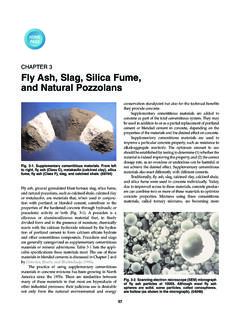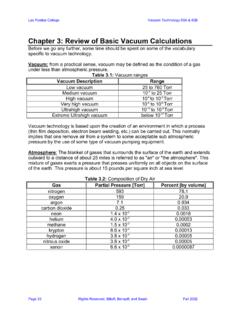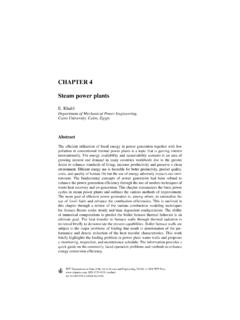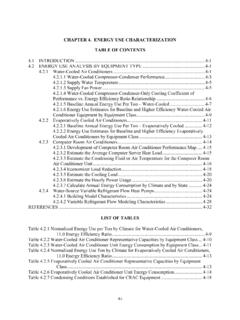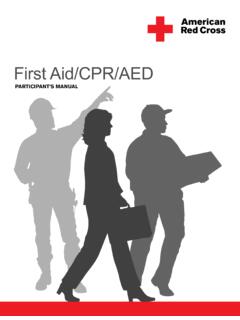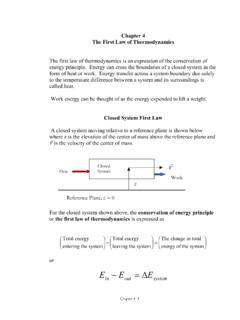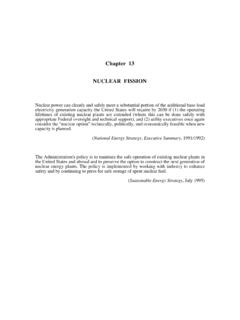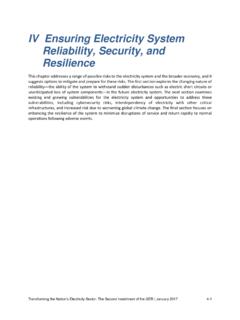Chapter 4 Heat Review
Found 12 free book(s)Fly Ash, Slag, Silica Fume, and Natural Pozzolans, Chapter 3
www.ce.memphis.eduprocessed materials, which are heat treated in a kiln and then ground to a fine powder (Figs. 3-10, 3-11, and 3-12); they include calcined clay, calcined shale, and metakaolin. ground granulated blast furnace slag and ACI 233 (1995) provides an extensive review of slag. SILICA FUME Silica fume, also referred to as microsilica or condensed
Chapter 3: Review of Basic Vacuum Calculations
lpc1.clpccd.cc.ca.usChapter 3: Review of Basic Vacuum Calculations Before we go any further, some time should be spent on some of the vocabulary ... neon 1.4 x 10-2 0.0018 helium 4.0 x 10-3 0.00053 methane 1.5 x 10-3 0.0002 ... molar heat capacity (const press) Cp J/k-n molar heat capacity (const volume) Cv J/k-n Reynolds number RE
CHAPTER 4 Steam power plants
www.witpress.comCHAPTER 4 Steam power plants E. Khalil Department of Mechanical Power Engineering, ... waste heat recovery and co-generation. This chapter summarizes the basic power ... use of fossil fuels and enhance the combustion effi ciencies. This is outlined in this chapter through a review of the various combustion modeling techniques for furnace fl ...
CHAPTER 4. ENERGY USE CHARACTERIZATION TABLE OF …
www1.eere.energy.govbegan with a review of the existing market as well as the review of historical shipments data provided by the Air-Conditioning, Heating, and Refrigeration Institute (AHRI) and discussed in chapter 8 of the TSD.
BOEING 737-800 TECHNICAL REVIEW - CHAPTER 1
737exam.comTECHNICAL REVIEW - CHAPTER 1 _____ Aircraft General DIMENSIONS Width : 35.79 m Lenght : 39.5 m Wingtip radius : 22.9 m ( do not turn away from an obstacle within 7.4 m of the nose ) EMERGENCY EXIT LIGHTS Three positions : - OFF (prevents unwanted illumination and unwanted battery usage)
First Aid/CPR/AED - American Red Cross
www.redcross.orgHeat-Related Illnesses and Cold-Related Emergencies 85 Bites and Stings 88 Poisonous Plants 98 Lightning 99 Putting It All Together 100 CHAPTER 7 Soft Tissue Injuries 101 Wounds 102 Burns 109 Special Situations 112 Putting It All Together 116 SKILL SHEET: Controlling External Bleeding 11 7 SKILL SHEET: Using a Manufactured Tourniquet 118
CORAL BLEACHING – A REVIEW OF THE CAUSES AND …
www.coris.noaa.gov4.2.1 Factors that influence resistance The variability that characterises bleaching events points to an important fact: individual corals vary in their responses to heat and light stress.Variability in bleaching response has been observed within individual coral colonies, among colonies of the same species, and
Chapter 4 The First Law of Thermodynamics
resources.saylor.orgChapter 4 -1 Chapter 4 The First Law of Thermodynamics The first law of thermodynamics is an expression of the conservation of energy principle. Energy can cross the boundaries of a closed system in the form of heat or work. Energy transfer across a system boundary due solely to the temperature difference between a system and its surroundings is
Chapter 5 Thermochemistry
web.ung.eduChapter 5 Thermochemistry Figure 5.1 Sliding a match head along a rough surface initiates a combustion reaction that produces energy in the form of heat and light. (credit: modification of work by Laszlo Ilyes) Chapter Outline 5.1Energy Basics 5.2Calorimetry
Chapter 13 NUCLEAR FISSION
personal.ems.psu.educonstant quantity of heat. This heat can be dissipated easily (see below) and the temperature of the material can be maintained below its melting point. This self-sustained chain reaction is illustrated in Figure 13-4. A self-sustained chain reaction is achieved by the use of a material that is capable of absorbing neutrons.
Chapter 17: Change of Phase - Austin Community College ...
www.austincc.eduReview 17-21.doc - 1 - Chapter 17: Change of Phase Conceptual Physics, 10e (Hewitt) 3) Evaporation is a cooling process and condensation is A) a warming process. B) a cooling process also. C) neither a warming nor cooling process. Answer: A Diff: 1 Topic: Change of State 4) Evaporation is a cooling process because
Chapter IV Ensuring Electricity System Reliability ...
www.energy.govNov 28, 2016 · Chapter IV: Ensuring Electricity System Reliability, Security, and Resilience 4-4 Transforming the Nation’s Electricity Sector: The Second Installment of the QER | January 2017 Resilience is the ability to prepare for and adapt to changing conditions, as well as the ability to withstand
